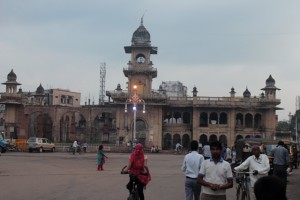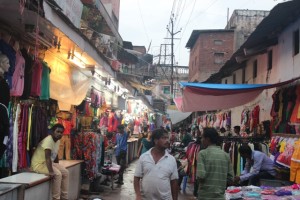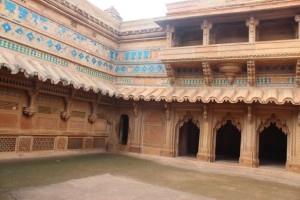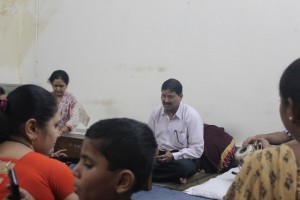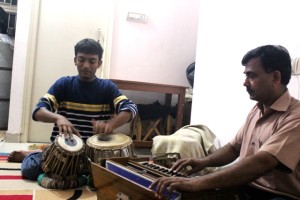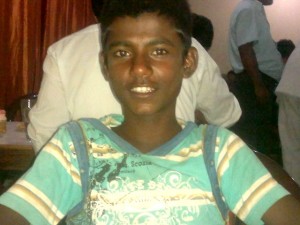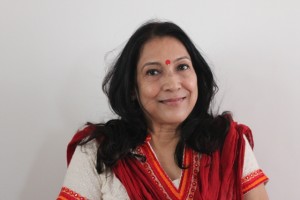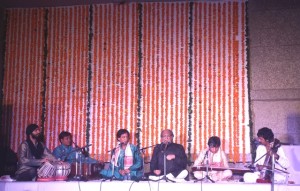The alaap strained through the tightening dusk before it was devoured by the traffic cacophony on Achleshwar Road. Kaalu gave me a triumphant ‘Didn’t-I-tell-you-it-was-here’ look. In all fairness Kaalu did say that but by then we had looked everywhere else. I managed to nod an appreciation as I backed Red into a parking slot twisted between a low hanging bough of a banyan or maybe a coral tree and a wobbly side mirror – unhinged by a brake-free rickshaw at the Bada Bazaar which we combed earlier that evening. We had gone around the market, the busiest area in Gwalior, asking everysecondseller for the Gwalior gharana. In fact, Kaalu did the asking while I waited in the car, which didn’t do much to protect my mirror. “He knows Gwalior like his backyard.” I was assured that morning by the tourist guide outside Gwalior Fort as he pressed Kaalu into my service. “Just tell him where you want to go.”
“Maybe we should ask some older people.” I told Kaalu as he emerged from yet another shop and turned to shake his head at me, a cryptic update delivered through an animated Morse code.
“It doesn’t matter whom we ask, all of them are migrants from Bihar and UP.” Kaalu ruthlessly dismissed my suggestion and went about choosing respondents as per his own intense logic which I soon tapped into as basically every alternate stall which gave him ample time to mutter out his frustration in the choicest colour-fest of street-cuss. “These choots have no right to be here, they don’t know where a gharana is. Or even what it is.” I wasn’t sure whether the angst was directed more at the burgeoning migration and related issues including scant employment avenues or was a threnody – of sorts – to a heritage slighted by the apparent ignorance surrounding it.
“Come in and ask baba.” We were invited into a brightly-lit and surprisingly spacious inner recess of a kitchen utensil shop where a very frail and frightfully old man sat on a plastic chair. Actually he wasn’t sitting but all rolled up, wispy white beard and all, into the chair. The whole unit giving an impression of a protrusion on the cushion.
“These guys are looking for the gharana.” The son who ushered us in shouted into one side of baba’s head.
The baba was happy to hear whatever he heard and smiled.
“Did you have chai?” The wispy white beard doddered.
“No.” Kaalu answered. Even before Kaalu’s dishonest reply the son had stepped on it.
I could see the mesh and the shafts churning behind those rheumy, permanently amused eyes. I tried not to look victoriously at Kaalu who kept staring at baba incredulously and impatiently at the backdoor into which the son had disappeared to for our tea.
“They are looking for some gharana baba do you know where it is?” The son was back and hollered in baba’s general direction now. Kaalu’s lips which were pursed to slurp the tea began to widen with a smirk.
“Whose ghar?” Baba finally managed after repeated aural assaults – of those around him – by the son. Kaalu began an insensitive giggle and I tried to give him a stern look without looking at him. I really wanted to clutch my sides to sluice my own welling up laughter.
“Baba’s memory is not like what it used to be,” the son explained by way of apology as we headed out. “Since you said it was about music maybe you should ask at the Madhav Music College instead of roaming around the bazaar.”
As we walked towards the deserted forecourt of the college the alaap – which shows not just the intensity of training but even creativity – took on a more authoritarian momentum, revelling in its mellifluous gravity, regaling with a sonorous frivolity. We walked through the hallway lit only by the horizontal slabs of light falling on the floor from the windows of the flanking classrooms. Evening classes for the office-goers and special classes for students were in progress. The tans and the khatkas which serenaded us short shrifted our atlases. We smiled at each other – we did it, finally. We were closing in, for sure. It was possible that over the years the gurus with their shishyas shifted from under the grandpa tree and more bucolic settings to concrete classrooms in town.
“A ‘gharana’ is not exactly somebody’s hut or house or haveli,” Umesh Kampoowale, a faculty member, struck straight at the root of the confusion that had us driving around in circles. “When a new style of music is developed by somebody and taken forward for several generations it becomes a gharana.”
The Gwalior gharana is the oldest in the country thanks to the widespread royal patronage it received from the Mughal emperor Akbar to the recent Scindias. Music and arts scaled new heights under the reign of the Tomar king Raja Man Singh who built the famous Man Singh Palace. The inner courtyards of the palace, which the Baburnama describes as ‘the best and the loftiest’, hosted regular music and dance recitals by artists from all over the country. Man Singh with his queen Mrignayani were not just patrons but accomplished musicians themselves who composed many ragas on their own. Tansen was bought over by Akbar for his court at 100 times the salary given to a successful army general. Music maestros and students from all over the country converged here in large numbers.
“But today nobody comes to Gwalior to learn music,” said Mukesh Saxena, who taught tabla at the music college. “In fact all those from the famed Gwalior gharanas are now in Delhi and Mumbai where there is more money.” Mukesh also lamented the lack of opportunity for rising talents. “Any event, in order to attract sponsors, is forced to rope in established names only.”
“But surely those guys are up there for their mammoth talent as well?” I asked. Mukesh didn’t dispute this but invited me over to his house later that evening for a solo demonstration by a student. A mild mannered lad with an easy smile, Hitendra Shrivastava was waiting with his father when we reached Mukesh’s apartment in city outskirts close to midnight. Soon Hiten’s fingers began to fly over the taut tabla head like the wings of a high-octane butterfly, blurring the lines between the sur and kinar; from the peshkar, played at the start of a solo to the speedier rela strokes. Each crescendo was a sort of emotional frenzy and I sat in rapturous silence (Click to hear what I mean). We were floating along the fringes of a lost world. Kaalu sat transfixed “Just like what we see on TV” he told me later. “Like that guy with long, curly hair.” I couldn’t agree more.
Hitendra, who is only 17 years old, has been practising and perfecting his art for over a decade now. Today he gets to perform with famous names like Kumar Bose and makes an occasional appearance on All India Radio. Mukesh is confident that it’s just a matter of time Hiten breaks into the big league. But perseverance apparently doesn’t pay like it used to. The inundation of talent shows on television has seen the rise of a breed of ‘fast food talents’.
“Many kids come to me saying that they want to learn Hindustani classical in two months because they are auditioning for Indian Idol,” said Neelima Sharma, another faculty member of the music college who has cut many devotional and light romantic albums. I was at her apartment in a quiet, leafy locality near the City Centre next morning. Kaalu wasn’t with me as I was heading out to Orchha afterwards. “As a rising trend, this will surely see the demise of real talent,” Neelima confirmed my worst fears. “But on the upside, some of them get hooked in these few weeks and express a desire to learn more.”
“Was this the gharana you were looking for?” Kaalu had asked me the previous evening before he left.
There was no other way for the gharana to survive – you have to become savvy with the changing times. Take the Delhi Gharana, which, by the way lays claim to the oldest gharana in India tracing its roots to Amir Khusro. Its website offers not just training in music and dance but it even has a division called Dilli Gharana Entertainment which promises ‘comprehensive event management solutions which leave lasting impressions.’ Under the tutelage of the Khalifa – custodian – Ustad Iqbal Ahmed Khan, a band of very talented and pretty girls who call themselves the ‘Sufis of Dilli Gharana’ even made it to the Coke Studio show – a matter of immense pride for the Ustad himself.
“I guess this is the best we can do,” I told him.



